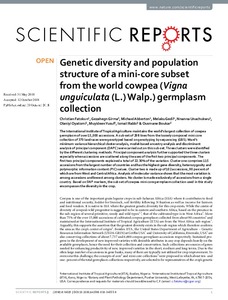| dc.contributor.author | Fatokun, C. |
| dc.contributor.author | Girma, G. |
| dc.contributor.author | Abberton, M.T. |
| dc.contributor.author | Gedil, M. |
| dc.contributor.author | Unachukwu, N.N. |
| dc.contributor.author | Oyatomi, O. |
| dc.contributor.author | Yusuf, M. |
| dc.contributor.author | Rabbi, I. |
| dc.contributor.author | Boukar, O. |
| dc.date.accessioned | 2019-12-04T11:26:32Z |
| dc.date.available | 2019-12-04T11:26:32Z |
| dc.date.issued | 2018-10-30 |
| dc.identifier.citation | Fatokun, C., Girma, G., Abberton, M., Gedil, M., Unachukwu, N., Oyatomi, O., ... & Boukar, O. (2018). Genetic diversity and population structure of a mini-core subset from the world cowpea (Vigna unguiculata (L.) Walp.) germplasm collection. Scientific Reports, 8, 1-10. |
| dc.identifier.issn | 2045-2322 |
| dc.identifier.uri | https://hdl.handle.net/20.500.12478/4641 |
| dc.description | Open Access Journal; Published online: 30 Oct 2018 |
| dc.description.abstract | The International Institute of Tropical Agriculture maintains the world’s largest collection of cowpea germplasm of over 15,000 accessions. A sub-set of 298 lines from the loosely composed mini core collection of 370 landraces were genotyped based on genotyping by sequencing (GBS). Ward’s minimum variance hierarchical cluster analysis, model-based ancestry analysis and discriminant analysis of principal component (DAPC) were carried out on this sub-set. Three clusters were identified by the different clustering methods. Principal component analysis further supported the three clusters especially when accessions are scattered along the axes of the first two principal components. The first two principal components explained a total of 22.30% of the variation. Cluster one comprises 115 accessions from the largest number of countries and has the highest gene diversity, heterozygosity and polymorphic information content (PIC) values. Cluster two is made up of 102 accessions, 90 percent of which are from West and Central Africa. Analysis of molecular variance shows that the most variation is among accessions and lowest among clusters. No cluster is made exclusively of accessions from a single country. Based on SNP markers, the sub set of cowpea mini core germplasm collection used in this study encompasses the diversity in the crop. |
| dc.description.sponsorship | Bill & Melinda Gates Foundation |
| dc.format.extent | 1-10 |
| dc.language.iso | en |
| dc.rights | CC-BY-4.0 |
| dc.subject | Cowpeas |
| dc.subject | Vigna Unguiculata |
| dc.subject | Food Security |
| dc.subject | Fodder Crops |
| dc.subject | Grain Legumes |
| dc.subject | Gene Banks |
| dc.title | Genetic diversity and population structure of a mini-core subset from the world cowpea (Vigna unguiculata (L.) Walp.) germplasm collection |
| dc.type | Journal Article |
| dc.description.version | Peer Review |
| cg.contributor.crp | Agriculture for Nutrition and Health |
| cg.contributor.crp | Grain Legumes and Dryland Cereals |
| cg.contributor.affiliation | International Institute of Tropical Agriculture |
| cg.contributor.affiliation | Purdue University |
| cg.coverage.region | Africa |
| cg.coverage.region | Asia |
| cg.coverage.region | East Asia |
| cg.coverage.region | East Africa |
| cg.coverage.region | West Africa |
| cg.coverage.country | China |
| cg.coverage.country | Kenya |
| cg.coverage.country | Niger |
| cg.coverage.country | Nigeria |
| cg.creator.identifier | Christian Fatokun: 0000-0002-8428-7939 |
| cg.creator.identifier | Michael Abberton: 0000-0003-2555-9591 |
| cg.creator.identifier | Melaku Gedil: 0000-0002-6258-6014 |
| cg.creator.identifier | Ismail Rabbi: 0000-0001-9966-2941 |
| cg.researchtheme | BIOTECH & PLANT BREEDING |
| cg.isijournal | ISI Journal |
| cg.authorship.types | CGIAR and advanced research institute |
| cg.iitasubject | Cowpea |
| cg.iitasubject | Grain Legumes |
| cg.iitasubject | Plant Breeding |
| cg.journal | Scientific Reports |
| cg.howpublished | Formally Published |
| cg.accessibilitystatus | Open Access |
| local.dspaceid | 101356 |
| cg.targetaudience | Scientists |
| cg.identifier.doi | http://dx.doi.org/10.1038/s41598-018-34555-9 |

